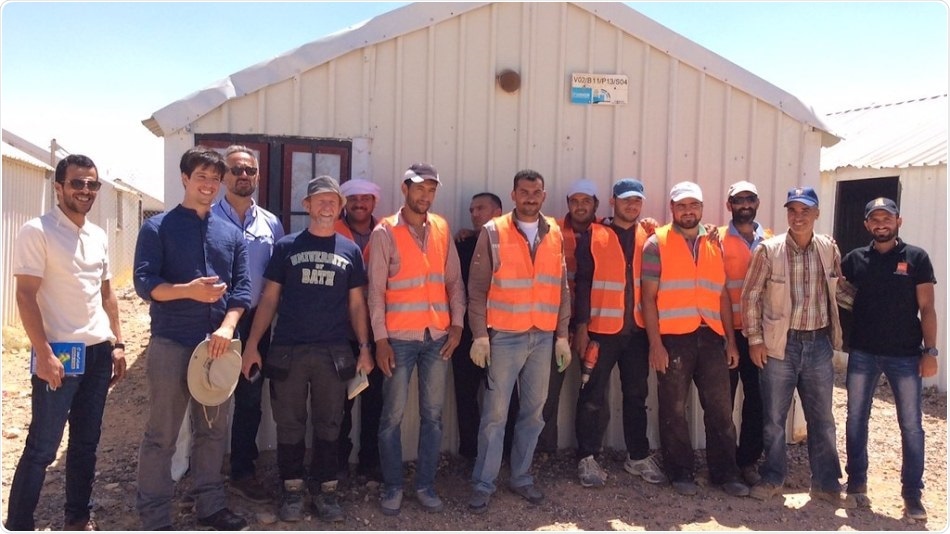The Healthy Housing for the Displaced Project is a world-leading study into how to improve shelter design to help the physical, mental and social health for occupants of refugee camps

The Healthy Housing for the Displaced Project build team at the Azraq camp in Jordan
The Healthy Housing for the Displaced Project, a world-leading study investigating how to improve the lives and health of displaced people in refugee camps by designing better shelters has shared its findings during Refugee Week 2020.
Engineers and social scientists from the University of Bath worked with refugees living in camps in Jordan, as well as colleagues from universities in Jordan, Turkey, Ethiopia and Peru over three years to investigate how engineering and design changes to shelters can improve occupants’ physical and mental health.
Through the largest ever global study investigating thermal comfort, air quality and social conditions in camps housing displaced people, the researchers tested a range of engineering measures that could reduce temperatures within shelters, to understand which bring the best ‘cost per degree’ reduction. Their findings have been shared with the UNHCR, to inform future plans.
The project team says their research shows an urgent need for further investigation into air quality within shelters. It is estimated that more than 20,000 displaced people die prematurely each year as a result of poor-quality air inside shelters, as they generally consist of a single room with little ventilation where socializing, sleeping and cooking (often on a wood fire without a chimney), all take place.
Other measures such as altering the layout of shelters to provide better privacy or more appropriate social spaces were also considered.
Aid agencies provide invaluable support and resources for large numbers of displaced people inside camps, but we’ve found that many existing shelter designs can create severe problems for inhabitants - most notably, the temperature inside some shelters can reach 46 °C. This in turn increases the demands upon those organisations, from people’s health being undermined. In addition, designs that don't meet the need for privacy and security can harm psychosocial wellbeing. Our findings show that simple engineering principles and the use of different materials can inform shelter design to ensure they naturally stay warm in winter and cool in summer, and suit the needs of displaced people from specific places.”
Professor David Coley, from Bath’s Department for Architecture & Civil Engineering and the project’s lead investigator
International and UK-based research
A total of 20 shelter designs with different combinations of insulation, design changes and equipment were used by the research team to understand which best bring about benefits to thermal comfort and at what cost.
Initially, eight different shelters were constructed at the University of Bath’s Building Research Park in Swindon to compare build times, and their different insulation measures tested. Following that, the best-performing measures were tested across 12 shelters at the Azraq refugee camp in Jordan over a period of months, with input from occupants of the camp.
The team found that a combination of measures, namely adding a desert cooling fan and filling a shelter’s walls with sand and gravel, provided the best overall temperature reduction in cost-per-degree terms. However, as not all measures will be available or appropriate to different camps around the world, the team is putting together a manual and digital tool for aid agencies that explains the benefits of each shelter design, provides guidance on matching design with context, and offers guidelines on construction.
Dr Dima Albadra, Lecturer in the Department of Architecture & Civil Engineering and a member of the research team, is herself a refugee, having been studying at Bath when the civil war in her home nation Syria broke out, leaving her unable to return.
Doing the participatory design workshops with refugees is perhaps the most rewarding piece of research I’ve done. These workshops served as a two-way design process, where the refugees were able to completely transform the shelters to suit their needs. It is very important to learn from their experiences to inform future shelter designs."
Dr Dima Albadra, Lecturer in the Department of Architecture & Civil Engineering
Two Jordanian Universities, Princess Sumaya University for Technology (PSUT) and the German Jordanian University, are partners on the project. Prof Omar Hasan (Bani Ahmad), Professor of Communications Engineering at PSUT, added: “PSUT’s contribution to this timely project is part of our corporate social responsibility agenda, and reflects our ongoing commitment towards supporting refugees.
“The work has enriched not only technical skills, but also deepened our understanding of the social dimensions and the impact of such projects on the lives of displaced people.”
Social and cultural context studied
Dr Jason Hart, Senior Lecturer in the Anthropology of Development within Bath’s Department of Social & Policy Sciences, and also a member of the team, said : "We have produced a huge amount of data that capture not only diversity of climate and natural environment but also of socio-cultural and political context.
“We are now analyzing this material for the purposes of publication and the development of a tool to guide shelter design. Our aim throughout has been to contribute to both academic debate and humanitarian practice, and we are now in the stage of finalizing that contribution."
The research team is set to publish more information on the issue of air quality within shelters in the coming months.
The Healthy Housing for the Displaced Project has received £2 million funding from the Engineering and Physical Sciences Research Council (EPSRC). Links to the research papers published by the Healthy Housing for the Displaced Project are available at https://www.hhftd.net/publication-archive.